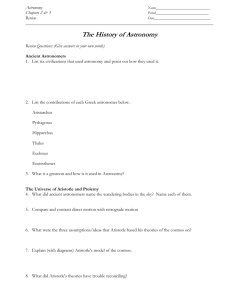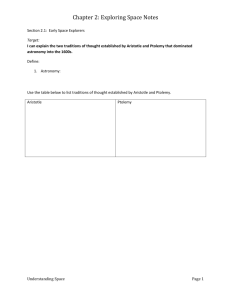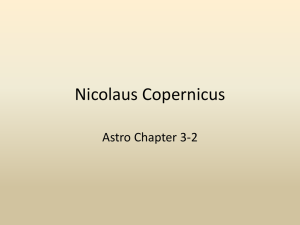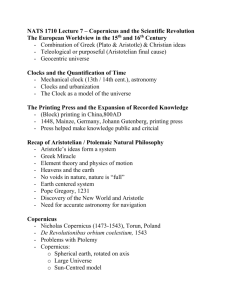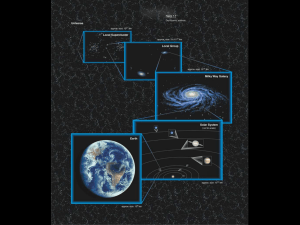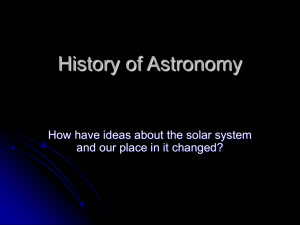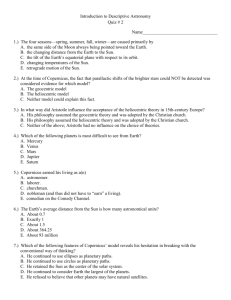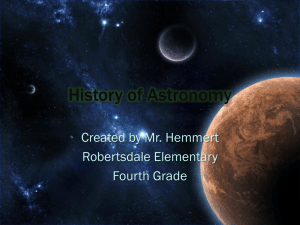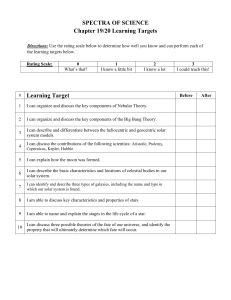21L.016 / 21M.616 Learning from the Past: Drama, Science, Performance
advertisement
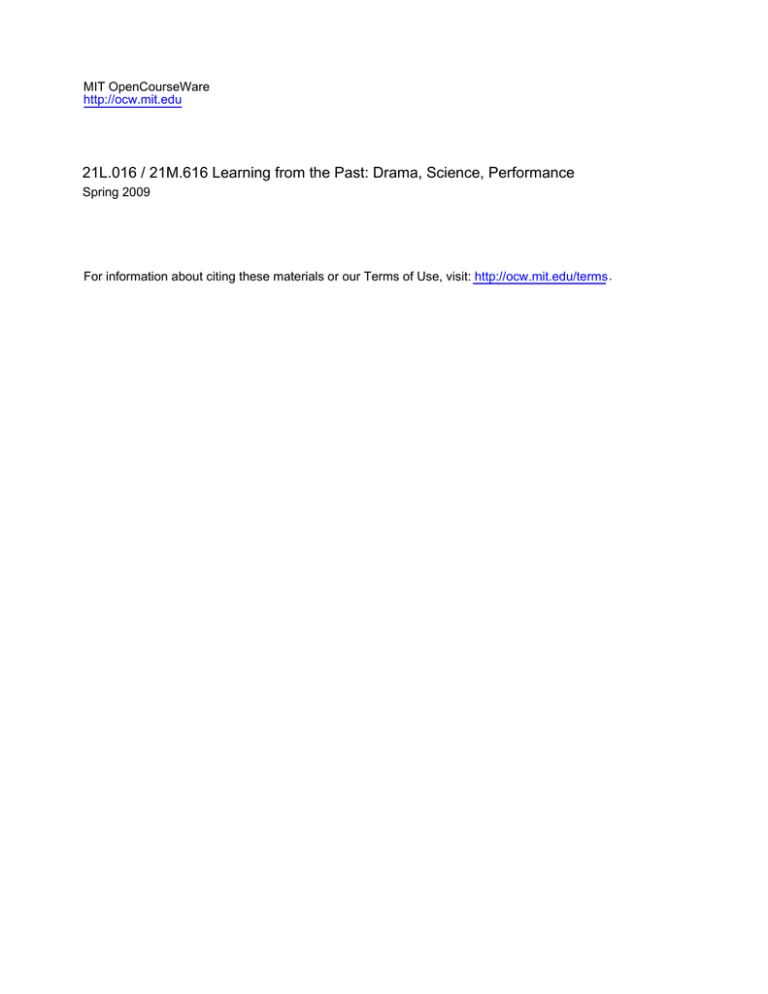
MIT OpenCourseWare http://ocw.mit.edu 21L.016 / 21M.616 Learning from the Past: Drama, Science, Performance Spring 2009 For information about citing these materials or our Terms of Use, visit: http://ocw.mit.edu/terms. From http://www.jonathanbaker.org/courses/ay9/notes.html. Accessed 31 August 2007. ASTRONOMY 9: HISTORYOF COSMOLOGY Handout #10 .J. F,. Raker T I C Rv~.k<:l<:,v. S p r i r ~ g2000 Cosmology in Ancient Greece: Aristotle and Greek Astronomy I. Aristotle (384 322 DC) Student of Plato's Academy Founded Lyceum Worked in alnlost every field of 1inon.n science and philosophy! Profound influence on develop~nentof \Vestern science Ever?- effect must have a cause Important innovation: unil-erse can be described by natural laws inferred by rational thought Aristotle's physics: mostl?- quite wrong, but strong co~n~no~l-sense appeal - Founded science of mechanics (physics of motion) - Del-eloped the idea of "force", impetus theory of notion (wrong, but widely held even today!) - ,Thought force was required to keep Earthly objects in motion (didn't fully understand %ncrl%a) Aristotle applies his physics to the cosmos - Basic Earthly elements: air, earth, fire, r a t e r - 'Terrestrial and celestial physics are very different! - ,Two types of "natural" motion A) Earth: linear, straight-line, finite notion (air and fire go up. water and earth go domrn) D) Heavens: perfect. eternal, circular motion - Bodies are impelled to move to their "natural" location - Can onl?- have one center 3 only one world - Circular motion nlust ha>-e a corresponding basic elenlent 3 5th element (quintessence): ether (heavenly, unchanging) - Cosmic division: A) Sub-lunar?- sphere (inside moon's orbit): earthly. changing. becoming, imperfect, made of 4 ele~nents(Ionian) D) Celestial realm (moon and beyond): immutable, perfect, made of ether (Eleatic) - Objects don't get "left behind': 3 Earth is fixed at the cosmic center - Earth known to be spherical on obscrual%onal grounds: A) Circular shadow during lunar eclipse D) Different stars become visible mrl~entravel north/south - Heavens are rotating 3 Universe nlust be finite! - Space has an unapproacl~able"edge" - Universe is eternal. untreated - God rules from outside (primary cause of all motion) - Appropriates Eudoxus' sphere nod el to explain planetary notion - Better observations require more spheres 3 55 total! (Still no esplanation for varying brightnesses) - Aristotle thinks spheres are physically real - No "\Toid" (vacuum), unlilie the Atomists 11. Heraclides of P o ~ ~ t u(c. s 388 31U IIC) Proposed rotating Earth to explain daily rotation of heavens Proposed >Iercur?- and Venus orbit Sun, not Earth Ideas rejected by Aristotelians 111. Aristarchus of Sa~nos(approx. 310 230 BC) "The Ancient Copernicus" hfeasuri~igthe size of the cosmos... Estimated size of Moon to be = 113 size of Earth (from lunar eclipse shadow-) Measured angle betvieen Sun and Moon when hloon is half-full (called "first quarter") Concluded Sun is 18 2Ux further away than Moon But apparent (angular) sizes of Sun and 14oon are the same 3 Sun is at least 18 times as big as 140011, or 6 times as big as Earth! Used inaccurate data (Moon diameter 2', actuall?. 0.5'), and method doesn't w-ork vie11 in practice: Sun is actually mucli bigger still! Heliocentric model: Sun is a t the center! Correct but rejected b?- Aristotelians, forgotten for 1500 years ... Science is not a linear progression of ideas! IV. Eratosthelies of Cyrene (276 194 DC) Clever measurement of the circumference of the earth Distance between Alexandria and Syene (now Aswan, Egypt) measured to be 5000 "stadia" (Greeli unit of length) Compare noon shadon-s a t summer solstice, find 7.2' difference Assume Sun is far am-ay so that rays are parallel Circumference is then C' = (g) x 5000 stadia = 50 x 5titiU stadia = 250, ti00 stadia, Length of stadium is uncertain; result vias very accurate if 1 stadium = 157.2 meters: C' = (250. 000 stadia) x 1 = (250, UOU stadia) x 157.2 m - ( 1 stadia) (-1 ' i "'lim 1.. Appollo~iiusof Perga (approx. 262 190 BC) Back to the geocentric cos~llos A nevi answer t o Plato's challenge to %a\-e the phenomena" Different from Eudoxus' "onion" cosmos of spheres, more like a Ferris wheel Not totally geocentric: introduced "eccentric circle" - Eartli renlains nlotionless a t cosnlic center - Planets still move in circles at uniform speed - But center of circles is ~ i o w displaced from Earth! - Apparent motion as viewed from Eartli is of variable speed Also in\-ented epicycle - Wheels upon wheels - Allows (complicated) explanation of retrograde nlotion "Theorist": did not tr?- to apply ideas to observational data VI. Hipparchus of Rhodes (190 120 DC) Great Greeli astro~iomer Synthesized Babylonian and Greek data with new Greek geometrical models from Appollonius - hfodel for Sun's motion (eccentric circle) - hfodel for hloon's motion (eccentric epicycle) Also made accurate catalog of 850 star positions Disco\-ered precession of equinoxes + ASTRONOMY 9: HISTORYOF COSMOLOGY Handout #11 .J. F,. Rt,kvr T I C R~:l.k<:l<:,v. S p r i r ~ g2000 Lecture Notes by I. R. King: Greek Astronomy and the Ptolemaic System 1 Heraclides 1Ve're going to go through toda?- the developments that led to the Ptolemaic system of the motion of ' was planets around the Earth, but the developnlent of Greek thought, and in particular Greekr aclence, far from nlonolithic and undeviating. Two "aberrations" el-en appeared that are part of our modern vie-, of the world: Heraclides suggested that the daily rising and setting of the sun, moon. and stars could be explained by a rotation of the earth on its axis, and Aristarchus (and probably Heraclides too) thought that the Earth went around the Sun. But these ideas attracted little attention or following. (I don't think Ptolemy el-en nlentions Aristarchus or bothers to refute him.) Now it's ver?- easy today to say, .'Oh. those stupid Greeks! They had people who knew the right answer. but they ignored them." Dut this of course is a ridiculously naive view-. They lived in a different world, with views that in lnany ma?-s are just as intelligent as ours, but different fundamental ideas were dominant. In particular, philosophy dominated over scientific inquiry, and Aristotle's ideas about the nature of the earth and the heavens ruled out both of these motions of the earth. And let's not forget the role of co~nnlonsense: everybod?. knows that whenel-er you accelerate you can feel it, and we certainly don't feel the earth spinning or rushing around the sun. But I don't want to get off 011 this side track; let's get back to the developnlent of Greek astronomy. Ilut that brings us right back to i2ristarchus. - 2 Aristarchus His heliocentric picture hasn't survived in ariting; we knom7 of it o11l?- through mention by others. Dut one thing he did was definitely mainstream: measuring the relative distances of the moon and sun. Illagnificent in principle. but Raved in practice, for tw-o reasons. First, it is hard to measure the time of quarter moon precisely. (This is usually excited to explain the poor accuracy of his result.) Second, and rarel?- noted, is the fact that the eccentricity (ellipticity) of the moon's orbit malies it move with varying speed, ahich vitiates the ahole idea, unless you take an average over many moon orbits. The nlonthly 7-ariations are :-lox larger than the effect Aristarchus was trying to measure. 3 Eratosthenes One other quantity that was measured in ancient times is the size of the earth. Around 200 IIC. Eratosthenes, who lived in Alexandria, had heard that in the town of Syene, some distance to the south of him, the sun vias exactly overhead on the summer solstice (when the sun is farthest north). From the length of a shadow in .$lexandria, he measured that the sun mas 7.2' from his zenith at solstice. This angle is 1/50 of a full circle, so the circumference of the earth is 50x the distance from S?-ene to Alexandria. The accuracy of his result is not known with certaint?., because the size of the unit he used is not known. A confusion of units also seems to have affected Columbus, who thought that the earth's circumference was s~nallerthan it really is (and used the erroneous figures to justify his voyage across the ocean). 4 The Problem of Planetary Motions The greatest achievement of ancient science rz-as the aorking out of an accurate description of the co~nplicated motions of the planets (for example, retrograde motion). How- do we get around this? Appollonius (c. eon DC) came up a i t h the idea of the epicycle. Another problem was no11-unifornl speed, ~ v l ~ i cinh the Aristotelian universe vias unacceptable. It 7cas well knoan that the sun doesn't move uniformly throughout the year; the lengths of the four seasons differ by several days. Appollonius had a solution for this one too: the eccentric circle. Motion vias not around the cosmic center (earth) but rather around a displaced point. (Ironic that the greatest ancient authority on ellipses seems never to ha\-e thought of using them for orbits!) 5 Hipparchus Hipparchus (c. 140 DC) vias the greatest observer of ancient times. He cataloged about 8 j 0 stars, and observed the positions of the planets (Hipparchus was to Ptolem?- as q c h o later vias to Iiepler). Magnit u d e s ( a logarithmic measure of brightness) in his catalog established the system of magnitudes that vie use today. Hipparchus also applied the ideas of Appollonius (the eccentric and epicycle) to real planetary data. Ptolemy (c. 150 AD) was the last great natural philosopher of classical times. He vias responsible for putting together a picture of planetary motion that stood until the beginning of modern times. (He also drew the best viorld atlas of ancient times, ~ v l ~ i clater h influenced Colu~llbustoward thinking that China was a reasonably short distance west of Europe!) He 7crote a great compendium of math and astronomy: /ie?strroi, or Almagest in its Arabic version. Ptolemy used observations made by Hipparchus to measure the p a r a l l a x of the moon. He seems to have gotten the right answer. but made two big mistakes which remarkably canceled out! Parallax exists for the stars too (since the earth moves round the sun) but is very small (since the stars are very far aviay). Whereas earlier scientists had been assembling ideas and observations (e.g., epicycle and eccentric of Appollonius; obserl-ations of Hipparchus, whose importance Ptolemy ackno~vledges),it a a s Ptolemy who finally put it all together to nlake a system that worked that is, it would fit observed positions in the past and could be used t o predict them in the future. (Ironically, the greatest practical importance for this system was considered to be its use for astrology, 7chic11 of all ignorant superstitions is the one that modern astrono~llersmost abominate.) The epicycle is the central device of the Ptolemaic system it can explain retrograde nlotion (ahich is much easier to explain in a heliocentric system!), but it's not enough. Ptolem?; had to nlake things really fit ~vell. He used the eccentric, which can account for varying speed. Today. vie know that each planetary orbit has a different eccentricity (that is. degree of ellipticity or non-circularity) of its orbit. So in the Ptolenlaic system, each planet has its circular orbit centered a t a different place. But even on an eccentric circle. he still couldn't get the speeds right ~ v i t huniform inotion ( a philosophical necessity), so he devised a new- trick. the e q u a n t . This is another point. distinct from both earth and the center of the eccentric circle, from which the planet appears to svieep out equal angles in equal times. IVhen you come to study Copernicus, you'll find that he was quite complace~ltabout epicycles and even used some small ones himself, but he despised the equant. In summary, a Ptolemaic orbit is defined by the d e f e r e n t , epicycle, eccentric. and equant. Ptolem?found nunlerical values for each of the seven "planets" (including Sun and bloon), that aould fit the observations of his day as vie11 as those of Hipparchus, nearly 300 years earlier. His model provided a good fit (within a fraction of a degree) to all planetary motions for several centuries! Some medieval Arabic astronomers added subsidiar?. epicycles, greatly complicating the system and leading to the idea that Ptolemy piled epicycles on top of epic?-cles. In fact, he didn't, and it was the (relatively) simple system just described that came into western Europe in the thirteenth century and was used there. Ptolemy had succeeded brilliantly a t solving Plato's old challenge to "save the phenomena". Dut his model had some shortcomings. First, it didn't contain any physics no explanation of why things move the way the?- do. (But note Copernicus also lacked physics, which 7cas only supplied a century and a half later by i'iewton.) Secondly, there were some suspicious coincidences u~lesplainedby Ptolemy's model. One was that the centers of the epicycles of Mercury and \Tenus were fixed on a line between the earth and sun. A second coincidence rz-as that retrograde nlotion al7cays takes place 7chen the planet is in the opposite direction from the sun (at opposition). Ilut it worked, and it fit many Aristotelian principles, so it 71,as just fine in its day. ASTRONOMY 9: HISTORYOF COSMOLOGY Handout #12 .J. F,. Raker T I C Rv~.k<:l<:,v. S p r i r ~ g2000 Cosmology in the Middle Ages I. Early Middle Ages (approx. 200 1200 AD) Background - Rise in power of Christianity as state religion - Instituted b?- E~nperorConstanti~le (324 AD) - Roman Empire divided into 13:est (Latin) and East (Greek, Byzantine) - ,Time of great tur~noil(invasion. social decay. corruption ...) - Attempts to repulse Gernlanic and Persian invaders fail; Rome falls in 400s, start of European "Dark Ages" - Catastrophic, fatalistic world-views mirrored in salvational themes of Christianity Greek curiosity about nature and love for reason are lost Natural philosophy no longer of interest. concern onl?- with abstract theological questions l:er?; few Greek writings survive Plato's Timaeus still widely read, also enc?-clopedic works of Latin compilers (Pliny. IlIacrobius. Capella, Chalcidius) Literal interpretation of scripture generally the final authority on cosmology Scholarly works all in Latin, knowledge of Greek fades Loss of Greek knowledge near total; from about 300 1000 AD, no st "educated" western Europeans believe in flat Earth! Neo-Platonis~ngenerally dominates during this period St. Augustine (334 43U) - Leads a wild, pleasure-seeking life until age 31. then adopts Christianit?- after tr?-ing man?other philosophies - Philosophy seen as mere handmaiden to theology, not a distinct path to truth - Strongly influenced by Platonic ideas - Division of world into For~ns vs. imperfect, shadowy reality, parallels the Christian "Fall': from grace - Plato's ideas wedded to Christian dogma - The Confessions: a~nplifies Plato's distrust of knowledge gained through the senses - Curiosity about the world, knoaledge for its own sake, seen as an inherently sinful pleasure - Ideas further amplified by Augustine's follomrers St. Lactantius - Demolishes "pagan" idea of spherical Earth in Dinine Institutions (written 30% 323) - Earth believed flat for first time in almost lUU0 years! - Argues against possibility of the antipodes Cosmas - First detailed description of early medieval cos~nological s?-stem. in Christian Topography (written 535 547) - Cosmos as a giant Tabernacle r I\tuch like earlier BabylonianlHebren, views r Earth as flat rectangle or disc at the bottom of the universe r Cos~naswas widel?- traveled, should ha\-e known better! r Earth surrounded by waters, also celestial waters above r Heavens are not spherical because Isaiah says God "laid them out like a tent" r Earth is tilted so the sun can go literally "down" r Tabernacle divided into two Aristotelian zones by firmament r Angels carry stars daily below the firmament Philoponus (6th c.) - Argues against the c o ~ l l ~ l labuse o ~ i of scriptures to prove non-spherical heavens - Ideas have little influence on dominant Church Isidore (570 636) - Bishop in western Church - Also mentions spherical heavens and earth, going against the orthodosy Bede (appros. 673 735, English monli) - Another unorthodox teacher of spherical Earth - Moves Earth from cos~llic bottom back to center - Influenced by Pliny Virgil or Fergil (8th c., Irish ecclesiastic) - ,Threatened mritli expulsion from Church for teaching of spherical Eartli - But not much happens; co~iden~nation of cos~llologicalheresy not at all strict Gerbert - Noted scliolar and astronomer, becomes Pope Sylvester I1 in 999 AD - Spherical Eartli n o r firmly reinstated Immutability of tlie Heavens - Like Aristotle, believed in perfect, unchanging celestial realm for 1LIoon and above - Appearance of supernovae in 1006 and 1054 barely even noted, though 1006 as bright as quarter Moon! - As evidence of celestial change, clashed with medieval viorld-view - Chinese astronomy reached high-point, left records of many celestial events including the SNe By 1000, European knowledge roughly same as 500 BC Greece! 11. Cosmic I~inovatio~i in Arabia (approx. 7UU 125U AD) Preservation and translation of man?- important Greek works (Ptolemy, Aristotle. Euclid, ...) Significant contributions to mathematics (algebra, numerals, sin function, ...) Re-introduction of Greek texts to Europe via Islanlic Spain starting in 1200s Sparked rebirth of scientific curiosity in Europe at end of Middle Ages Built large, organized observatories for new tables of planetary motion A) Adalusian school (Iberian peninsula) Followers of Aristotle's physics: uniform, geocentric, circular motion is only natural possibility Rejected Ptolemaic equant (non-uniform), epicycles and eccentric (not geocentric) as against physical principles Reverted to Aristotelian model with concentric spheres Predictions for planets off by up to 21'1 B) hfaraglia school (Persia) Desired to improve accuracy of Ptolemaic model with new data and mathematical tricks alLTusi ( d . 1274) invented 'Tusi couple - Combination of two circles. one smaller inside tlie other - Can produce variety of motion, even linear! Ptolemy's eccentric and equant replaced with Tusi couples Back to uniform circular motion, w-ith little loss of accuracy 111. Late I\tiddle Ages and Early R.enaissance (approx. 12UU 15UU) By mid 1200s, translations of Aristotle and Ptolem?- come to Europe 7-ia Arabia and Spain Philosophers comnlent on ancient Greeks, add few- new ideas Aristotle's influence eclipses Plato's St. Thomas Aqunias ( l 2 2 i 1274) - Marriage of Aristotelian ideas and Christian dogma Revelation still nlost important source of knowledge, but natural philosophy recognized as a distinct path to truth, followed w-hen not directly contradicting scripture - Aristotelian physics instituted as dogma, not challenged - Believed Aristotle already contained all that could be know-n about the world, nothing left to discover! - Problems uniting .iristoile with Christianit?-: A) Eternal vs. created cosmos B) Only one world a limit on God's power? Roger Bacon (1214 1294) - Unlike most, did not follomr Aristotle as dogma - Stressed use of experiment as path to truth - Establishment of scientific method - Iniprisoned for tw-o years for prornoting "dangerous novelties" Dante (approx. 1300) - Divine Comedy presents dominant medie\-a1 view of cosmos - Hierarchical chain of being, walled-in, finite cosmos - Aristotelian lunary/sub-lunary dil-ision subdivided into man?- concentric shells - Outer shell is most perfect, angelic; Lucifer a t center of Earth Nicolas of Oresme (1323 1382, France) - Wrote Book of the Heanens and the World - Familiar with Heraclides' idea of rotating Earth - Notes rclatiuc nature of notion - Argues rotation of Earth more natural than rotation of heavens! - Refutes his own ideas at the end of the work - . . . . . Nicolas of Cusa (1401 1464, France) - Argues for unbounded, eternal universe in On Learned Ignorance - Earth moves! - Forced to w-rite apolog?., quotes ancient philosophers Regiomonta~~us (1436 14i6) - Completes Peuerbach's translation of Ptolemy's Almagest from original Greek - Discovers errors up to 2' in planetary motions. eclipse ends one hour early Colunlbus (1492 trans-Atlantic voyage) - Did not have to convince anyone of spherical Earth (fiction invented by American writer TVashington Irving) - Knea of accurate 9th c. Arabic conlputation of circumference - Got value 25% too small by assuming Arabic mi = Ronlan mi - Wrong Ptolemaic geography, thought Asia extended far east - Used to justify vo?-age - Europe not a t cosmic center ASTRONOMY 9: HISTORYOF COSMOLOGY Handout #13 .J. F,. Raker T I C Rv~.k<:l<:,v. S p r i r ~ g2000 Copernicus: A Reluctant Revolutionary I. Nicolas Copernicus (1473 1543, Poland) Moves Sun back to (aell, near) center Revolutionary implications: - Earth is just another planet going round the sun - Demolisl~esAristotelian spheres and walled-in nlediesal Christian universe - Universe becomes vast (lack of parallax) - Erases division of earthly vs. celestial realms - Aristotelian physics unsatisfactory: where is the center? - Breaks the close link between man, god, and universe - Loss of stability, rest, order - ,The Greeks did not discover all scie~ltificknorvledge Idea that our place in universe is not special: still called the Copernican Principle But these re\-olutionary ideas mere not trumpeted (or even consciously recognized) by Copernicus! Merely implied by his work Heliocentric idea at first welcomed b?- relativel?. ope~l-mindedChurch! Big trouble onl?- decades after death of Copernicus, around 1600 Copernicus was conservative, backward-looking, unwitting instigator of his revolution Last Aristotelian of the great scientists, a t home in the medieval cosmos By standards of his day, Copernicus vias a relic of an earlier world view! - Aristotelian physics long called into question by Bacon, Oresme, Cusa. ... - Aristarchus' heliocentric ideas never really forgotten. and were discussed openly prior to Copernicus - Winds of humanist Renaissance blowing from Italy, little effect on Copernicus despite his studies at Bologna - Still answering Plato's challenge to "save the phenomena", not trying to revolutionize cosmology Blind faith in ancient authority - Data mostly from Ptolemy - Only 2 i recorded observatio~lsof his o a n , didn't bother to get modern instrunlents - Spent a lot of energy accou~lting for \-ariation (not really there) in precession of equinoxes Other inlportant revolutions going on - Luther's 95 T h c s c s and Reformation - Inventio~l of printing press rise of vernacular - ,Journey of Columbus Europe is not the center of the world? Caged in almost Pythagorean secret?., little courage of conviction, plagued by doubts and fears of ridicule (but little threat of religious persecution) ,The Copernican system - Introduces even m o r e epicylces than Ptolem?-! (About 48 vs. 40) - No real observational i~nprovement over Ptolem?- Only circular motions - Sun is displaced from center of orbits as bad as the despised equants! Born of w-ealthy merchant parents. influenced b?- overbearing uncle Lucas and scandalous brother Andreas Studies some astronomy at Univ of Cracow (149Us) Studies Canon law- at Bologna (1496) Studies medicine at Padua (1301) Cuslly job as Canon of Frauenburg cathedral, few- responsibilities Unsocial life largely spent loclied aviay in lonely tower a t Frauenburg Few human relationships: lived w-ith houselieeper . h n a Schillings until ordered by C l ~ u r c lto ~ get rid of her (Counter Reformation), one close friend (Giese), one disciple (Rheticus) Motivation for heliocentric idea: Ptolemy's equants not in accord with Aristotelian ph?-sics! Commentariolus (Little Commentary): preliminary announcement of heliocentric idea, manuscript only, 1510 1514 Seven axioms: A) Heavenl?. bodies do not all move round same center B) Earth is center of moon's orbit and terrestrial gravity, but not universe C) Sun is the center of the universe D) Earth's distance from Sun mucl~smaller than to stars E) Earth's rotation causes daily rising and setting F) Annual motion of Sun against fised stars due to Earth's orbit G) Retrograde notion also due to heliocentric orbits First Account: written by Rheticus, no nlention of Copernicus by name, 1539 On the neuolut%onsof the Heavenbg Spheres, 1543. one of the worst-selling books in history! Not placed on Index of forbidden boolis for 73 ?-ears Copernicus delays publication for decades, finally gives in to pressure from Rheticus and Giese In dedication to Pope, Copernicus mentions Giese and others who influenced him, but not Rheticus! Rheticus demoted from Dean a t 1Vittenburg to mere cushy Prof at Leipzig due to his l~omosesualit?Leaves publicatio~~ of Rcuolutions to pal Osiander Osiander views heliocentric idea as mere calculating hypothesis, does not believe in its t ~ n t h Anonymously adds preface which goes too far in appeasing theologians: Copernicus merely "saving the phenomena" Died of cerebral hemorrhage 1543, may have just see11 published copy of Itevolut%ons 7citl1 Osiander's preface Hit on idea of ellipse for planetary motions, but for the wrong reasons and by faulty logic! Crossed out in manuscript Given Copernicus' trepidation and lack of originality and courage, why 7casn't heliocentric nod el hit on earlier? - Ph?-sics wasn't there yet deficiencies in Aristotle recognized, but no replacement yet - Copernicus was really interpreting Ptolem?;, not nature; vaste of time to humanist scientists \Vh?- does Copernicus get all the attention? - He systematized the heliocentric idea into a cosn~ological nod el (though one rooted in the past) - 1Vritings attract notoriety (mostly heresa?-) a t the right time 11. Thomas Digges (1546 1595. England) 'Translated part of Copernicus' Rcuolutions Leader of Englisl~Copernicans Precise obserl-ations of rycho's (1573) SN Lack of par all^^ implied very large distance Added a new idea to Copernican model: infinite space. viith stars at varying distances ASTRONOMY 9: HISTORYOF COSMOLOGY Handout #14 .J. F,. Rt,kvr T I C R~:l.k<:l<:,v. S p r i r ~ g2000 Tycho Brahe and Johannes Kepler I. Tycho Drahe (1546 1601. Denmark) The "i2stronomer Prince", a very eccentric character, pompous and arrogant nobleman l35i: Studies law in Copenhagen (age 13) 1358: Witnesses partial solar eclipse. amazed that astrono~nicalevents are prcdzc2ablc, devotes self to astronom?Dispute with relative over who mas best at math 3 duel, nose sliced off and replaced with silver! Inlportant recognition: astronomy needs continuing observations of greater precision and accuracy Builds improl-ed instruments. becomes greatest pre-telescopic observational astronomer Positional data accurate to 2' (1130th of a degree)! Important astronomical events in Tycho's life A) 1558: Partial solar eclipse l3) 15i2: Superno\-a in Cassiopeia - No measured parallav 3 well beyond the moon in Aristotle's celestial realm - Heavenly change, contradicts Aristotelian cos~nos C) 1 5 i i : Conlet - Limits on parallax 3 at least 6x farther than Moon - No mere "atmospheric phenomenon"! King Frederick I1 gives Tycho the entire island of Hveen! Tycho builds grandiose observatory Uraniborg. "Castle of the Hea3-ens" Rules the island in grand dictatorial style T?;cho's cosmolog?; - Compromise between geocentric and Copernican ideas - Earth remains notion less at cos~niccenter (plausible, since fixed stars did not ha\-e measurable parallax) - Sun goes round earth as in geocentric model - But other planets go round Sun, as in Copernican model! - Note: Tycho's model breaks the "celestial spheres" Beconles "Imperial illatliematicus" to Rudolph I1 in Prague (1596) 1601: Dies of uremia after dinner with the Rosenbergs. "let me not seem to ha\-e lived in vain" 11. Joliannes Kepler (1571 1630, b. Germany) Founded '~astrophysics" Search for mathematical law-s to describe natural phenomena (planetary motion) Nightmarish childhood Attended Lutheran seminary from age 13 17 Prof of math and astronomy at Gratz by age 231 Kepler deeply influenced by Pythagorean thought - Beauty of geometr?; and mathematics - Harnlony of the spheres - Co~ivinced tliat cos~llosmust be geo~netricallybeautiful - Mystical inspiration for work Kepler's .'day job':: astrology! - 1601: w-rites treatise tliat breaks with principles of Ptolemaic astrology - Tries to make astrology more "certain", based on harmonies - Importance a t imperial court of Hal?- Roman Emp. Rudolph I1 Thought souls interacted with planets, "the hidden cause" Kepler's main obsession: significance of the fact that there were six known planets - Toda?- vie knom7 that pla~lets formed out of gravitational instability in a disk-shaped nebula 5 billion years ago - Fact that there are 9 is an '.accident" of the initial conditions of the nebula (rarity of such a configuration is unknown so far other solar s?-stems look very different, but vie can't detect similar ones to our own for another decade or two) - For Kepler. six planets nus st be related to the fil-e regular polyhedra (Platon%c solids) - Solids with regular polygons as faces and all vertices look the same - Can prove that only five exist: A ) Tetrahedron: 4 triangular faces. 3 edges a t each vertex B) Octahedron: 8 triangular faces, 4 edges at each vertex C ) Icosahedron: 20 triangular faces, 5 edges at each vertex D ) Cube: 4 square faces, 3 edges at each vertex E ) Dodecahedron: 12 pentagonal faces. 3 edges at each vertex - Kepler thought that planets moved 011 six spheres circumscribed and inscribed around the five solids - Finall?- failed t o reconcile w-ith observations, though fit to within about 5%)error - l:er?- modern scientific innovation: if theory doesn't fit the observations, nlust discard it! "Under a calamitous sky", Kepler marries a rich widow, "simple of mind and fat of body" with a "stupid, sulking, lonely, melancl~olycomplexion" l:er?; personal and amusing (though obscure) writings, unusual record of the blind alleys and frustrations in scientific thought 139i: Mysteri7~mC08mographicum (Secret of the Uniuersc) - Presents Kepler's cosmology in\-olving Platonic solids - First outspoken defense of Copernicus (50 ?-rs after death!) - Search for the physical causes of planetary motion Kepler recognizes that he needs good data 3 Tycho 1600: Tycho invites Kepler to join him; rocky relationship. constant arguing Tycho know-s Kepler has theoretical brilliance to interpret his data, but jealously guards his data After Tycho's death, Kepler gets Tycho's title and data Struggles long and hard trying to understand the motion of Mars Heliocentric model of orbit of Mars using circles leads to a stubborn error of 8'. even wit11 use of equant "Because these 8' could not be ignored. they alone have led to a total refor~nationof astronomy." 1609: Astronomia Noua (Neur Astronomy) - Problem of orbit shape; spends years trying all kinds of ovals and epicycles, finall?- stumbles across answer - First 2 of Kepler's t h r e e laws: 1. Planetary orbits are ellipses with Sun a t one focus 2. Orbits sweep out equal areas in equal times - Finall?- smashes the dogma of unifornl circular motion! - No more epicycles - First precise, verifiable natural laurs - Work on magnetisnl at this time by William Gilbert (1544 1603, physician to Elizabeth I ) - Kepler thinks the planets are held in their orbits by "magnetic" force from Sun ahich "diminishes in ratio to distance as does the force of light" - Comlection of Earthly with celestial - Tantalizingly close to idea of u~liversalgravity, but doesn't quite get it - Kepler's cosmos and the Holy Trinity: Father Sun at center, Son Sphere of stars at circumference, Holy Ghost force from Sun in intervening space 1619: Harmonice Mundi (Harmony of the Worlds) - Importance of Pythagorean harmony and geometr?- - - Compares ratio of min/mau distances of each planet from Sun rz-it11 musical harmonies; music of the heavens! After much trial and error, stumbles onto T h i r d law: P L cx a3 r P = period of planet (how long to go around Sun) r a = semi-major &xis of ellipse (for special case of circle, radius) r If P in years. a in A.U., then constant is 1: r A.U. = astronomical unit = Earth-Sun distance = 1.5 x 1U"m 1621: Epzlomc of Copcrnzcan Astronomy - Generalization of 3 laws t o all planets - First textbook of Copernican astronomy - Placed on Index of forbidden books . . . 162i: Rudolphznc Tablcs - Use of 3 laws t o predict planetar?- motions Kepler still does not understand physical reasons why his laws exist ... S o m n i u m : last published work - First real modern science fiction story - Dream of a journey to the moon Dies sickly and poor, unable to collect monies owed to him ASTRONOMY 9: HISTORYOF COSMOLOGY Handout #15 .J. F,. Raker T I C R~~.k<:l<:,v. S p r i r ~ g2000 Galileo I. Giordano Bruno (1548 16U0, Italy) Philosopher, victim of rrligious pcrsccution (one of about two rcputcd scholars in 1500 1700) 13i2: Ordainled as pricest Belief in infi~lit<c univcrsc, multitude of worlds (Cusa. Diggcs) Other solar s?-stcms a i t h worlds inhabited by bcings similar to hu~llans Panthcist, hrld that Jesus was mcrcly a sorccrcr Dcficndcd virws as philosophical, not theological; ricfuscd to 111aloc a formal rictraction Scntcnccd by R o ~ n a nInquistion, burnc:d at stake for religious hcrcsy in 1600 Inspircd later liberal humanist thought, anticipated idcas in modern cosmology (though his arguments wlcr,: philosophical, not scicntific) 11. Galilco Galilci (1564 1642, Italy) Major contributions to cos~llologicalscicncc: - Introduced tclwcopc as icsscntial tool for astronomy - Advocated hclioccntric Copernican modicl - Strcsscd icxpcrimcntal mcthods in scicncc - hfcchanics: formulated principle: of inertia - Also contributed to othccr scicntific disciplin~cs "Sccond-gcncratio~~~ Rcnaissancc man, fully modern in outlook Wrotlc in Italian vernacular - Easily read, tcrsc, scirntific ariting style (very diffcr<cntfrom others!) - Altcrnatcs bctw<ccnbrilliant d<cfilns<cs of fr<cicdo~n of thought and sophistry, dcccption - Grand po1c:mical st?-lc: builds up argunxcnts for opponcnts' viicws, thcn dcmolishcs thcm and malics t h r m looli foolish - Crcatcs a lot of cncmics! Contcmpt for opponcnts' intclligcncc 16U9: Galilco malics a tclcscopc - ~Thcoricticalideas discussed around 1600 by Kcplcr and othcrs - First t~el~cscop~:~ made in Holland around 1608 - Galilco constructed his basrd on rcports of thw<c - Set apart from othrrs by improvcmcnts, madic morc pon,crful scoprs - Gave 8 x scoplc to \icnctian scnatc for military dcfcnsic, rcviardcd with tcnurc and doubled salary - ~T~cl~cscopic "discovcrics" A) Mountains, cratcrs, valleys ( .'7naria": seas) on th,: b1oon: cc:lc:stial objlccts not perfect sph<crcs! D) Four I ~ O O I I S orbiting Jupitcr, a "mini-Cop<cmican" system. "Mediccan" stars, dubbcd "satcllitcs" by I<cplcr: composite motion of Earth's >10011 not an argument against Copc:rnicus C ) Found many stars invisibl<cto nakccd cyc. bfilliy 1%- made of stars! - Announced in Siderius Nuncius (Slurry Messenger), imm,:diat,c slcnsation - Laticr "discovcrics": A) Two lobes around Saturn (scopc not pow-crful enough to tell thcy wicrc rings) D) Spots on the Sun (Jcsuit astronomer Schcincr argued w?rc satcllitcs. Galilco showed on or near Sun's surfacc) C ) Venus goes through full silt of phases D ) Comrts (2, inauguraticd 30 li?ars W'ar): liloc Aristotelians, G. argued they wcrc illusions: (comctary orbits vcry elliptical, so did not fit with original Copcrnican circular modcl!) \'c:r?- jealous of priorit?., sccrctivc: communicated disco\-crics in anagram form "You cannot help it ... that it was granted to mc alon,: to discovcr all the ncw phcnomcna in the sliy and nothing to anybody clsc. This is the truth which nc:ithcr malicc nor cnvy call suppress." Galilco and Copcrnica~iisnl - 'Taught hclioccntric idcas of Copcrnicus - In Icttcrs, claimcd bclicf at an ccarly agc - No c o ~ n ~ n i t tto a l Copcrnicansi~ni n p7~blishedwork until agc 50 - Galilco's rcal filar ( u p to age 50 or so, no rcal threat of religious pcrsccution): bcing laughcd off the stage by mcdiocrc Aristotclian professors! - Iicplcr cncouragcd him, apparently taken as rcproach (G. vcry scnsitivi; to criticism!) - Ig~iorcdIicplcr's idcas and prcachcd the original Copernican modcl, with all its ugly cpicyclcs! Copcrnicanis~nand thc Church - 161U: No official position on cosmological systcms - Models arc to bc considcrild scientific hypothcscs, not "Truth" - Galilco blo~vs up after hilaring rumors of dinner-part?- con\-crsations(!) whcrc Copcrnicanis~n said to conflict m-ith scripture (c.g., Grand Duchcss Christina, 1615) - Letter to Christina (originally to student Castclli) r Claims Copernican nlodcl is factually trne r Calls for rdntcrprctation of scripturc r Subtly shifts burden of proof to thcologians: thcy nlust dcnlonstratc Copcrnicanism is false, othcrwisc rdntcrprctation nlust 11appc:n by default! r Church's position: show- us proof of thcory, only thcn ail1 wc rcintcrprct r Inaccurate copics of lcttcr scnt to I~iquisitionby G.'s opponc~its - Copcrnicus' Revolutions placcd on Index for 4 ycars until 9 scntcnccs regarding "truth" of t11c modcl wcrc changcd - 1616: Cardinal Dcllar~ninc to G.: do not "hold or dcfilnd Copernican thcory ,The Competing Cosmologies - Popc Urban VIII: admirer and supportcr of G. r Copcrnicanism may work, but all-powcrful God could producc samc phcno~nc~ia by diffcrcnt mcalis - 163U: D%alog Concerning T W OChief World Systems r Characters: Salviati (G.'s spolicsman), Sagrcdo (intclligcnt person), Si~nplicio("simpleton", Aristotclian) r Simplicia givcs thc Pope's argumcnt 3 bad consi~qui~~iccs for G.! r Remains on 11idc:x until 1835 - G. forced dccision bctaccn Ptolcmy and Copcrnicus, ignorcd 'Tycho's nlodcl and Iicplcr's icl1ipsi:s - Ptolcmaic s?-stcm rulcd out by phascs of \<:nus, qucstion rcally bctmrciln Copcrnicus (+ Iicplcr) and Tycho - Dcfilcts in Copcrnicus: ,cpicyclcs (ignoring Iicplcr), lack of stcllar parallax (argument for 'Tycho), Sun not a t icxact ccntilr - Galilca~l noons sho~vcdcomposite motion, so w-hy not let plancts ~nov,:around Sun plus Sun around Earth (Tycho)? - Galilco thought hc had thc rcquircd proof of thc Copernican modcl: theory of the tides (reall?- a sclf-delusion!) r At midnight. orbital and rotational motions add: viatcr "falls bchind" r At noon, subtract: watcr "rushcs ahcad': r Contradicts G.'s o a n idcas about inertia! r Prcdicts onl?- onc high tidc per day, at cxactly noon! (Actuall?. t ~ v o times , constantly shifting) r Iicplcr had corrcctly gucsscd tides wcrc dull to Moon (G. dismissed as occult nonscnsc!) - Galilco and thc Inquisition - Qucstioncd beginning in 1632. age 68 - Provcd that G. had "hcld, dcfi:ndcd, and taught" Copcrnicanism as truth, callcd his opponents "mcntal pygmies" and "dumb idiots'' - Afraid, dcfcatcd, and brokcn, renounces his bclii:fs - G. rcpcatcdly dcnics what is in his own book, prctcnds hc had not supported Copcrnicus sincc dccrcc of 16161 - According to lcgcnd (probably untrui:), muttcrs eppur S% muoue - Ncvcr went to prison, held in .'house arrcst" in a rather nice villa - Co~itinucs his most important work: thc scicncc of d?;namics Contributions to mechanics (study of motion) - Cul~nination of work by carlicr post-Aristotelians (c.g.. Orscmc) - 16U9: Study of falling bodies: d K t Z ,parabolic trajcctorics - I n e r t i a : objects at rest stay at rest, obji:cts in motion continu,: in motion (straight-line, constant speed), unless actcd 011 by somc cxtcrnal force - Forcc sc:c:n as ncccssar?- to alter motion, not sustain it as in Aristotlc - 'Thought cxpcrim~:nt of frictionless, i~iclincdplan,: - Rclatil-ity of motion, simplc addition of vclocitics - 1636: Dialogues Concern%ngT W ON e w Sciences Died in 1642 (New-ton born), boncs of ~niddli:fingc~now- displa?-cd in Florcncc i\lusrum for thc History of Scicncc Was the conflict bctwrrn religion and scicncc incvitablc? - Probably not, marc a rcsult of indil-idual pcrsonalitics - Church had adaptcd bcforc (spherical Earth, about 1 O O O AD) - Might have 111ovi:d to Tycho's nlodcl as a prcludc to truc hclioccntric modcl, had G. not forced t h issuc ~ - Lasting rcpcrcussions: hostility of Church towards scii:ntific cosmolog?; - G. not "rchabilitatcd" by Romc until 1992!
